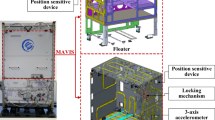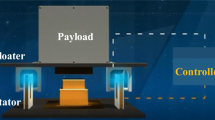Abstract
The Microgravity active vibration isolation system (MAIS) is a device to reduce on-orbit vibration and to provide a lower gravity level for certain scientific experiments. MAIS system is made up of a stator and a floater, the stator is fixed on the spacecraft, and the floater is suspended by electromagnetic force so as to reduce the vibration from the stator. The system has 3 position sensors, 3 accelerometers, 8 Lorentz actuators, signal processing circuits and a central controller embedded in the operating software and control algorithms. For the experiments on parabolic flights, a laptop is added to MAIS for monitoring and operation, and a power module is for electric power converting. The principle of MAIS is as follows: the system samples the vibration acceleration of the floater from accelerometers, measures the displacement between stator and floater from position sensitive detectors, and computes Lorentz force current for each actuator so as to eliminate the vibration of the scientific payload, and meanwhile to avoid crashing between the stator and the floater. This is a motion control technic in 6 degrees of freedom (6-DOF) and its function could only be verified in a microgravity environment. Thanks for DLR and Novespace, we get a chance to take the DLR 27th parabolic flight campaign to make experiments to verify the 6-DOF control technic. The experiment results validate that the 6-DOF motion control technique is effective, and vibration isolation performance perfectly matches what we expected based on theoretical analysis and simulation. The MAIS has been planned on Chinese manned spacecraft for many microgravity scientific experiments, and the verification on parabolic flights is very important for its following mission. Additionally, we also test some additional function by microgravity electromagnetic suspension, such as automatic catching and locking and working in fault mode. The parabolic flight produces much useful data for these experiments.














Similar content being viewed by others
References
Brck, S., Reu, M., Richter, H.E., et al.: Microgravity Sci. Technol. 16, 31 (2005)
Bushnell, G.S., Becraft, M.D.: Microgravity Performance Flight Characterization of an International Space Station Active Rack IsolationPrototype System. In: Proceedings of the 16th IEEE Instrumentation and Measurement Technology Conference. Inst. of Electrical and Electronics Engineers, Piscataway (1999)
Dong, W., Xi, L., Li, Z., Ren, W.: Electronic design for chinese microgravity active vibration isolation system. IAC-11-A2.5.6 , Cape Town (2011)
Edberg, D., Boucher, R., Nurre, G., Whorton, M.: Performance Assessment of the STABLE MicrogravityVibration Isolation Flight Demonstration. In: Proceedings of the 38th AIAA/ASME/ASCE/AHS/ASC Structures, Structural Dynamics, and Materials Conference, pp 1478–1485. AIAA, Reston (1997)
Gao, Z.: Scaling and parameterization based controller tuning. In: Proceedings of the 2003 American Control Conference, pp 4989–4996 (2003a)
Gao, Z.: Scaling and Bandwidth-Parameterization based controller tuning. In: Proceedings of the 2003 American Control Conference, pp 4989–4996 (2003b)
Gao, Z.: Active disturbance rejection control: a paradigm shift in feedback control system design. In: Proceedings of the American Control Conference, pp 2399–2405 (2006)
Gao, Z., Huang, Y., Han, J.: An alternative paradigm for control system design. In: Proceedings of IEEE conference on Decision and Control, pp 4578–4585 (2001)
Grodsinsky, C.M.: Survey of active vibration isolation systems for microgravity applications. J. Spacecr. Rocket. 37(5), 586–596 (2000)
Gu, Y, Gao, M., Zhao, G., Guo, J.: Utilizations in China manned space engineering. IAC-09-B3.4.5 (2009)
Han, J.: Auto-disturbance rejection control and its applicationss. Control and Decision 13(1), 19–23 (1998)
Han, J.: Nonlinear design methods for control systems. In: Proceedings of the 14th IFAC World Congress (1999)
Kawanami, O., Ohta, H., Kabov, O., et al.: Microgravity Sci. Technol. 21(Suppl 1), 3 (2009)
Liu, W., Li, Z., Dong, W.: etc. Modelling and simulation for Microgravity active Vibration Isolation Platform in Space Station. 65th IAC IAC-14-a2.5.4, Canada (2014)
Melnikov, D.E., Ryzhkov, I.I., Mialdun, A., et al.: Microgravity sci. Technol. 20, 29 (2008)
Novespace: 27th DLR parabolic flight campaignPractical and technical information. DI-2015 (1997)
Novespace: Novespace A310 zero-g interfaces document, ITF-2014-8 (2014a)
Novespace: Novespace experiment design guidelines in parabolic flight GDL-2014-6 guidelines en (2014b)
Novespace: Experiment design requirements in parabolic flight. RQ-2015-1 (2015)
Pletser, V., Pacros, A., Minster, O.: Microgravity Sci. Technol. 20, 177 (2008)
Ren, W., Li, Z., Gao, Y.: Microgravity Active Vibration Isolation System for Space Science in China. 61th International Astronautical Congress, IAC-10-a.2.5.10 , Prague (2010)
Schmidt, W.: Microgravity sci. Technol. 19, 16 (2007)
Tryggvason, B.V., Stewart, B.Y., DeCarufel, J., Vezina, L.: Acceleration Levels and Operation of the Microgravity Vibration Isolation mount (MIM) on the Shuttle and Mir Space Station. In: 37th Aerospace Sciences Meeting and Exhibit, pp 99–0578. AIAA Paper, Reno (1999)
Whorton, M.: Robust Control for Microgravity Vibration Isolation. J. Spacecr. Rocket. 42(1), 152–160 (2005)
Zhang, Y., Dong, W.: Ect. Verification of the Microgravity Active Vibration Isolation System based on air floating platform and parabolic flight. AIAA Space Forum, AIAA-2016-5297, United States (2016)
Acknowledgments
This work is cooperated with German Aerospace Center (DLR) and supported by Space Utilization System of Chinese Manned Space TZ-1 Project. The authors thanks DLR and Novespace for their help during the parobolic flight campaign. Also We thanks Dr. Shao-qing Chen and Prof. Yong Wang of University of Science and Technology of China for their help on control system simulation.
Author information
Authors and Affiliations
Corresponding authors
Rights and permissions
About this article
Cite this article
Zhang, Yk., Dong, Wb., Liu, W. et al. Verification of the Microgravity Active Vibration Isolation System based on Parabolic Flight. Microgravity Sci. Technol. 29, 415–426 (2017). https://doi.org/10.1007/s12217-017-9559-4
Received:
Accepted:
Published:
Issue Date:
DOI: https://doi.org/10.1007/s12217-017-9559-4




